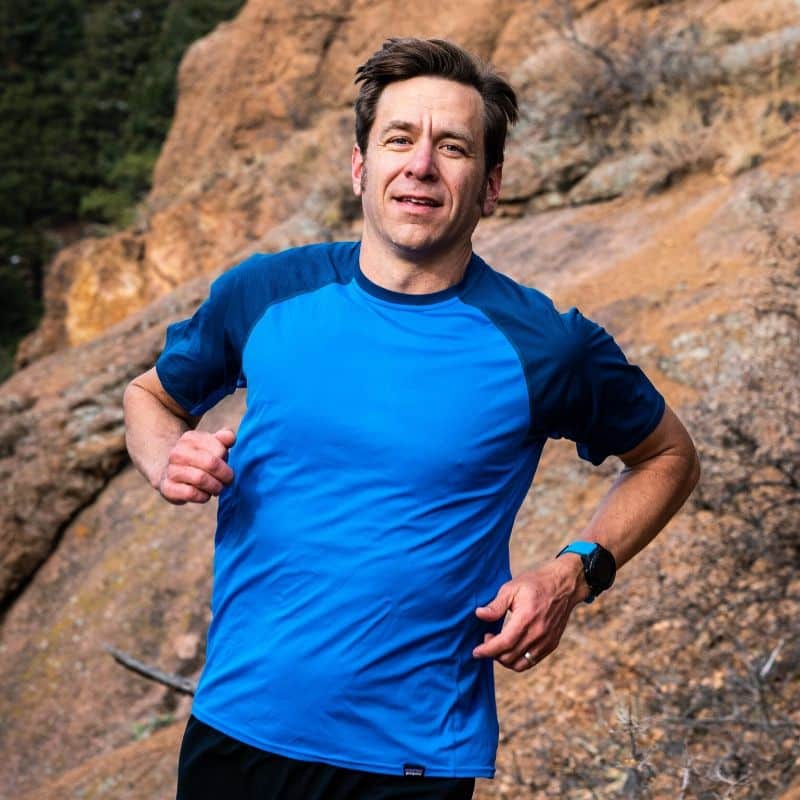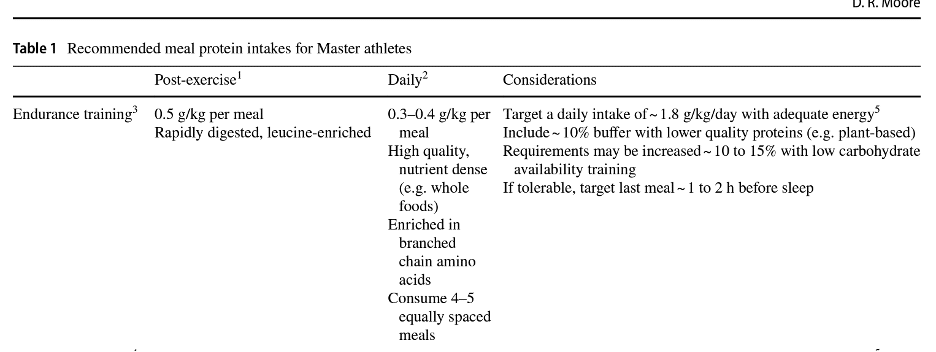
New Research Suggests Lowering Protein Requirements for Masters Athletes
By Jason Koop,
Head Coach of CTS Ultrarunning
For what seems like an eternity now, we’ve been warned about the potential for age to detrimentally affect muscle mass retention. Recommendations aimed at older athletes have become so ubiquitous you could go across any of the major endurance media outlets, from Runner’s World to Ultrarunning Magazine and find the basic same set of recommendations for Masters athletes to prevent age-related muscle loss:
- Strength train
- Do weight bearing activities (primarily aimed at cyclists and swimmers)
- Eat more protein
They’re not wrong, but a recent review paper written by Daniel Moore in the publication ‘Sports Medicine’ has applied greater scientific scrutiny to that last recommendation. The results might surprise you and could definitely pour some cold chocolate milk on the idea that athletes over 60 (sometimes referred to as Grand Masters) need more protein than younger athletes.
Origins of Elevated Protein Requirement for Masters Athletes
It has been well established that as we age, the body’s normal anabolic processes are less effective at taking dietary protein and turning it into muscle mass. This phenomenon is known as ‘anabolic resistance’, quite literally meaning resistance to the anabolic process. Research has demonstrated at nearly all steps of the anabolic process, from the time we begin chewing something like a steak all the way down to the metabolic signaling processes, older sedentary people simply show a reduced capacity to produce new lean muscle and conserve the muscle they have.
Take the simple act of chewing, which for many cases is the very first step of turning dietary protein into muscle tissue. It’s been well established that dental health tends to decline with age. And with this decline comes dietary changes like eating softer, less protein-dense foods as well as what’s known as reduction in ‘chewing efficiency’ (basically how effectively you break down food through mastication), both of which compromise your body’s ability to digest dietary protein. Once this protein is in your stomach, age-related gastrointestinal damage further reduces protein absorption. Move down the digestive chain a bit further, and even simple things like the capillary density within skeletal muscle (which is responsible for delivering amino acids to the muscles) is compromised by aging.
With research continually reinforcing these inefficiencies at every step, it’s a natural conclusion to recommend that older athletes need to consume more protein. After all, if less of it actually ends up repairing or building lean muscle tissue, it makes sense that you should eat more of it to make up for that difference.
Enter exercise.
Exercise reverses age related anabolic resistance
While the research overwhelmingly points to the fact that aging sedentary people need more dietary protein, it appears that aging athletes (> 60yrs) do not. And here is where the compilation of research really gets interesting. At nearly every step of the anabolic process, from mastication to metabolic signaling, exercise has some positive effect that counteracts the effects of age-related anabolic resistance. Take for example the capillary density issue mentioned earlier. Older individuals have poorer capillary networks, thus compromising amino acid delivery to the muscles. However, athletes – particularly endurance athletes – show greater capillary density compared to their sedentary peers, and in fact have a capillary network that is on par with their younger athlete peers (Coggan et al 1990). It’s one of the primary adaptations for endurance athletes.
Similarly, we can look at the signaling pathways the body uses to take amino acids and synthesize them into muscle protein. Amino acids serve as the building blocks for skeletal muscle. But that process does not happen magically. As amino acids enter our bodies, we need a way to turn these small building blocks into actual muscle tissue. The way your body does this is to recognize the amino acids floating around, combine that with a need to build new muscle (say damaged muscle from a workout), and then set off a cascade of metabolic signals to catalyze the process. Your body is literally saying, “Hey, I have a bunch of stuff to make new muscle, and I have the need to build new muscle, so I’m going to facilitate the process. Crank the music and disco lights and get this muscle building party started!”
These metabolic signaling pathways are compromised as we get older. In this way, even when protein is consumed and then broken down into amino acids, our aging body does not recognize them as readily as it once did, and those amino acids are simply not turned into muscle protein as effectively. All the party goers are there, but the DJ is just lame, and the party never starts. However, even very moderate exercise (45 min of walking) has been shown to enhance the metabolic signaling pathway in older untrained men. Thus, exercise acts as a protective agent even in this most microscopic part of the process.
Protein recommendations for everyone
So how much protein do endurance athletes actually need? Regardless of age, 1.8 grams of protein per kilogram of bodyweight per day will do the trick. This represents a minor reduction from previous recommendations of up to 2.0 g/kg/day for athletes over 60 years old. If you are interested in how this works out for a normal day’s worth of meals, there’s no better learning lab than to actually track your food in an app like carbon diet coach or My Fitness Pal. While this does take some time and energy, if you are serious about ensuring your macronutrient intake is adequate, there is no substitute for logging your foods. Many endurance athletes who do this are surprised by how low their actual protein intakes are.
We also know a lot about the bolus and timing of protein intake throughout the day. Current recommendations revolved around consuming ~30-40 g of protein throughout the day (4-5 feedings) and avoiding concentrating protein consumption on one or two meals per day (which typically happens at dinner).
These recommendations are summarized in the table below from the paper.
► Free Ultrarunning Training Assessment Quiz
Take our free 2-minute quiz to discover how effective your training is and get recommendations for how you can improve.
Caveat for Athletes Doing Two-a-days
Some of the research that led to recommendations for elevated protein requirements for masters athletes revolved around this study, where masters triathletes performed a downhill run and then either consumed meals with a moderate or a high protein intake after the trial. The athletes who consumed the extra protein performed better on subsequent tests later in that same afternoon. Whether or not these effects would carry over a full 24 hours later is unknown. Nonetheless, if I had a Masters athlete that was performing multiple two-a-day sessions, I would increase their protein intake as a precautionary measure.
What About Low Carbohydrate Training and Fasting
No nutrition article is complete without opining on the triggering topics of low carbohydrate training (training with low carbohydrate availability to promote greater rates of fat oxidation) and fasting. And to this point, the author of this particular review paper specifically addressed these two topical training interventions. For the record, I have written about these here, here, here, done podcasts on the topics here, here, here and answer Instagram/Twitter DMs on this literally every week. You don’t have to click on any of those links to find my summary: I don’t think fasting or training with low carbohydrate availability are good interventions to use for endurance athletes, as they cause far more problems than any potential advantages are worth. But don’t take my word for it. Here are some quotes directly from the paper-
For low carbohydrate training-
These approaches, whether intentional or due to dietary deficiencies, are a feature of many elite endurance athlete training programs
However, training with low carbohydrate availability has also been shown to augment amino acid oxidative losses as a compensatory energy source that can increase daily protein requirements by ~ 10 to 15%, which Master athletes need to be mindful of if they incorporate this type of training into their plans.
For fasting-
‘Given that protection from typical age-related muscle loss is equivocal in Master endurance athletes and performance benefits of TRF (Time Restricted Feeding) are not apparent in young athletes, older endurance trained athletes are cautioned about experimenting with this dietary approach in order to avoid any unintended muscle loss. Thus, it is recommended that Master athletes prioritize a balanced daily protein ingestion to maximize muscle remodeling and mass.
Enjoying This Article? Get More Free Running Training Tips
Get our coaches' best training advice, delivered straight to your inbox weekly.
References-
R. Coggan, R. J. Spina, M. A. Rogers, D. S. King, M. Brown, P. M. Nemeth, and J. O. Holloszy Histochemical and enzymatic characteristics of skeletal muscle in master athletes Journal of Applied Physiology 1990 68:5, 1896-1901
Doering, T. M., Reaburn, P. R., Borges, N. R., Cox, G. R., & Jenkins, D. G. (2017). The Effect of Higher Than Recommended Protein Feedings Post-Exercise on Recovery Following Downhill Running in Masters Triathletes, International Journal of Sport Nutrition and Exercise Metabolism, 27(1), 76-82.
Moore, D.R. Protein Requirements for Master Athletes: Just Older Versions of Their Younger Selves. Sports Med (2021). https://doi.org/10.1007/s40279-021-01510-0



Comments 5
Pingback: Substantial Fitness Gains You Can Make After 50 (and 60!) - CTS
Pingback: Myths about Post-Workout Protein and Recovery Drinks - CTS
This article made my day! I turn 70 in a couple of months and just finished dead last in a very flat, very fast marathon.
HOWEVER! LOL I came in third in my age group! And I have the ribbon to prove it! 🙂 There were only three of us over 60 who finished! The cutoff was tight and it was not a “walking” marathon.
Thanks for an article focusing on us geezers who tend to be “participants” rather than “competitors.”
Jason,
Another great article, thank you. I’m a (grand master) cyclist but still get great insights from your writings.
I’m curious your suggestions for those of us who train first thing in the morning. It’s not to intentionally fast, but I’m often jumping on the trainer minutes after getting out of bed (sometimes I can’t even fit a full hour in, but that’s the goal), and weekends are similar (rarely have time to eat a few hours beforehand).
During the week they’re usually one hour sessions so typically just water while utilizing stored reserves. I’m dosing with gels during weekend rides, with my first real meal (a gorge-fest with high quality protein and carbs around midday). For what it’s worth I follow a polarized training plan so the recovery rides are really slow, hard rides really hard): 4 ride days, 2 off-bike days (core and upper body, strength and flexibility) and one rest day.
Please help with your expert advice! Thank you.
Author
Tom,
Your morning routines – both weekday and weekend – are pretty common, and from your comment it appears you consume carbohydrate during the longer weekend morning rides. You might try adding a small dose of carbohydrate (100 calories or so) as you get on the bike for those weekday morning rides and see if it works for you. In either case, the protein recommendations and the caveats around fasting and low carbohydrate training mentioned in Jason’s article are more of a reminder that you might be using a bit more protein for fuel during exercise than other athletes. Consequently, you want to make consuming that 1.8 g/kg/day a priority because it’s more likely you’re going to need all of it. So, consider a carbohydrate and protein-rich (30-40g P) breakfast after your morning ride, and 30-40g doses of protein over 4-5 feedings throughout the day (inclusive of breakfast). A nighttime, pre-sleep feeding is OK, too, based on recent work from Shawn Arnt: https://trainright.com/nutrient-timing-for-endurance-cycling/
Jim Rutberg – Co-author, “The Time-Crunched Cyclist” and “Training Essentials for Ultrarunning”